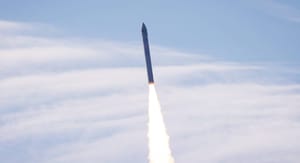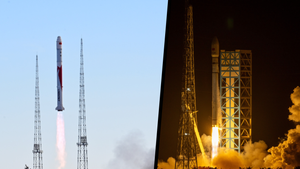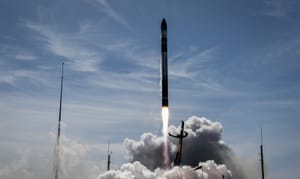
A little over four months ago, SpaceX flew the fourth flight test of its Starship-Super Heavy vehicle. Since then, the company has been working towards the fifth flight test and today announced that this test could come as soon as October 13th.
For this test flight, Ship 30 and Booster 12 are expected to fly. Both of these vehicles have completed static fire tests and partial propellant loading tests, it is unknown if a wet dress rehearsal will occur before launch.
As much as SpaceX would like this test to happen on October 13th, the U.S. Federal Aviation Administration has not yet provided the necessary regulatory approval.
SpaceX has also updated the schedules for both the countdown and flight plan with them now being as follows:
Countdown
| 01:15:00 | SpaceX Flight Director conducts poll and verifies GO for propellant load |
| 00:49:50 | Ship fuel (liquid methane) load underway |
| 00:48:40 | Ship LOX (liquid oxygen) load underway |
| 00:40:40 | Booster fuel load underway |
| 00:34:03 | Booster LOX load underway |
| 00:19:40 | Raptor begins engine chill on booster and ship |
| 00:03:20 | Ship propellant load complete |
| 00:02:50 | Booster propellant load complete |
| 00:00:30 | SpaceX flight director verifies GO for launch |
| 00:00:10 | Flame deflector activation |
| 00:00:03 | Raptor ignition sequence begins |
| 00:00:00 | Excitement guaranteed |
Flight Test Timeline
| 00:00:02 | Liftoff |
| 00:01:02 | Max Q (moment of peak mechanical stress on the rocket) |
| 00:02:33 | Super Heavy MECO (most engines cut off) |
| 00:02:41 | Hot-staging (Starship Raptor ignition and stage separation) |
| 00:02:48 | Super Heavy boostback burn start |
| 00:03:41 | Super Heavy boostback burn shutdown |
| 00:03:43 | Hot-stage jettison |
| 00:06:08 | Super Heavy is supersonic |
| 00:06:33 | Super Heavy landing burn start |
| 00:06:50 | Super Heavy splashdown if no catch attempt |
| 00:06:56 | Super Heavy landing burn shutdown and catch attempt |
| 00:08:27 | Starship engine cutoff |
| 00:48:03 | Starship entry |
| 01:02:34 | Starship is transonic |
| 01:03:43 | Starship is subsonic |
| 01:05:15 | Landing flip |
| 01:05:20 | Landing burn |
| 01:05:34 | An exciting landing! |
Compared to the previous flight test, the fuelling of liquid methane into the Ship starts fifty seconds sooner, and liquid oxygen loading starts one hundred seconds sooner. Booster fuelling also starts forty seconds earlier for liquid methane, with liquid oxygen loading starting almost three minutes later. Propellant loading is completed at the same time as flight four, likely due to the new propellant farm at the launch site.
In flight, booster 'most engines cut off' is now expected to occur eight seconds earlier along with hot-staging of the ship occurring four seconds sooner. The boosters 'boost back' burn is now starting one second sooner and ending eleven seconds earlier. Separation of the hot staging ring is still expected two seconds after this burn.
Unlike the previous flight, SpaceX is hoping that Booster 12 will fly back to Starbase for a catch on the launch tower. This test will have the booster hover above the launch site for a few seconds while the towers 'chopsticks' move in to catch it. If the booster aborts the catch attempt it will splash down in the Gulf of Mexico.
Like the previous flight text, the ship is expected to perform a 'flip and burn' for a landing following atmospheric reentry. The last flight had Ship 29 barely survive reentry and land, Ship 30 has a new heatshield design in the hopes of landing in one piece.
What is Starship-Super Heavy?
Starship-Super Heavy is SpaceX's in-development fully reusable super heavy-lift launch vehicle and the largest rocket currently flying. SpaceX is currently aiming to have the launch vehicle deliver one-hundred and fifty tons to low Earth orbit while reused or two-hundred and fifty tons when expended, although there are rumors from SpaceX of an expendable payload capacity of three-hundred tons.
On the launch pad, Starship-Super Heavy is one-hundred and twenty-one meters tall and weighs 5,000,000 kilograms fully fuelled. The diameter of both vehicles is nine meters, excluding aerodynamic control surfaces.
What is Starship?

Starship is the second-stage of the Starship-Super Heavy launch vehicle and is planned to be capable of multiple missions into orbit, after a short refurbishment. The vehicle is fifty meters tall and nine meters in diameter, excluding its four aerodynamic control surfaces. Fully fuelled with liquid methane and liquid oyxgen Starship is believed to weigh 1,300,000 kilograms with an approximate weight of 100,000 kilograms unfuelled.
The Starship second-stage is powered by three sea-level Raptor engines along with three vacuum-optimized Raptor engines. These sea-level engines are believed to generate 230 tons of thrust each with the vacuum-optimized engines generating 258 tons of thrust each for a total combined 1,500 tons of thrust for Starship. The vacuum-optimized Raptors are unable to gimbal requiring the sea-level Raptors for control of the second-stage on ascent and landing.
In order to survive re-entry for reuse, Starship has several thousand thermal protection tiles on one side of the vehicle and on all four of its aerodynamic control surfaces. The four control surfaces help guide the vehicle during re-entry and prior to landing inside the atmosphere at a pre-determined location. Starship also has a series of small thrusters to control the vehicle in space before re-entry.
SpaceX is believed to be working on a few variants of Starship for use as a Moon lander, propellant tanker, space station, Mars lander, and as a crewed spacecraft.
What is Super Heavy?

Super Heavy, also called 'the Super Heavy booster', is the first-stage of SpaceX's Starship-Super Heavy launch vehicle. The giant Super Heavy first-stage is planned to be capable of multiple flights per day with minimal refurbishments and inspections. The vehicle is seventy-one meters tall and nine meters in diameter, excluding its four grid fins and chines. Fully fuelled with liquid methane and liquid oyxgen Super Heavy is believed to weigh 3,600,000 kilograms with an approximate mass of 200,000 kilograms unfuelled.
The Super Heavy first-stage is powered by thirty-three sea-level Raptor engines generating a combined thrust of 7,590 tons, with each engine generating 230 tons of thrust. The outer twenty Raptor engines are unable to gimbal with the inner thirteen being able to for control of the first-stage.
To enable the reuse of Super Heavy, the vehicle has four large grid fins placed in the interstage to assist in guiding and controlling during descent. Super Heavy also has four chines running along the lower third of it to generate lift and assist in stabilization.
Shortly after completing the ascent, Super Heavy relights ten engines, as three were running during staging, and performs a 'boost back' burn in order to return to the launch site. After the 'boost back' burn is completed the engines shut down with Super Heavy being guided by a series of small thrusters and its grid fins. Once Super Heavy is at the correct altitude above its landing location three engines start back up for the landing burn. SpaceX currently plans to have Super Heavy land in the ocean with launch site landing attempts happening with later flights.
Super Heavy also features a hot-staging ring atop of it to allow for a faster and simpler staging process, according to SpaceX. The hot-staging ring has dozens of gaps on the sides to allow for the Raptor engine exhaust of Starship to escape.



